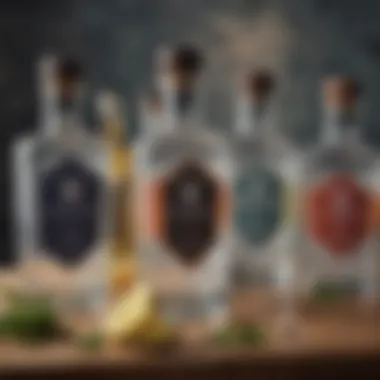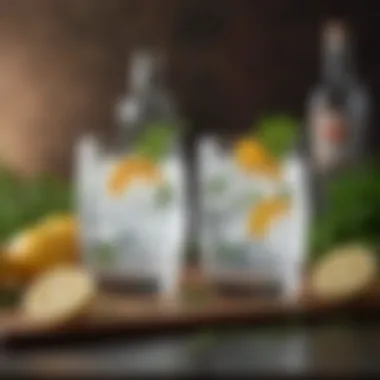Mastering the Craft of the Ideal Gin and Tonic


Intro
Crafting a memorable gin and tonic is not just about pouring a spirit over ice; it’s an experience, a ritual steeped in tradition and artistry. When done right, this seemingly simple cocktail evolves into a sophisticated dance of flavors and aromas that can transport you to a sun-soaked terrace or a lively bar in a bustling city. So, how does one achieve that perfect balance? This exploration takes us through the nuances that elevate a basic gin and tonic to a drink worthy of admiration.
From the careful selection of botanicals that kiss the gin to the fizzy embrace of tonic water, every ingredient plays its role. The art doesn’t stop there, as garnishing transforms the drink visually and sensorially, providing contrast and depth. Moreover, understanding the historical context and regional variations of this classic cocktail can add a layer of appreciation. With expert tips to refine your technique, we’ll delve deep into the craft of creating a gin and tonic that’s not just refreshing but also a conversation starter.
By the end of this article, you’ll not only know how to mix a stellar gin and tonic but also grasp its significance in cocktail culture. Let’s toast to exploring this charming beverage!
Recipe Overview
- Recipe Name: The Classic Gin and Tonic
- Brief Description: The Classic Gin and Tonic is a harmonious blend of gin, tonic water, and garnishes, characterized by its distinct botanical notes and crisp effervescence.
Ingredients List
Main Ingredients
- Gin (preferably one with a complex botanical profile)
- Tonic Water (high-quality, naturally flavored if possible)
Optional Ingredients
- Fresh lime or lemon wedges
- Herbs like rosemary or basil
- Spices such as cardamom or peppercorns
- Slices of cucumber or berries for a fruity twist
Using these ingredients and some skilled preparation, your gin and tonic can be elevated to new heights, showcasing both simplicity and sophistication. Every choice is a reflection of personal style, and there’s no right or wrong way to experiment, making this drink versatile and endlessly customizable.
"A good gin and tonic is an expression of the drinker's personality and tastes, making it unique to every glass."
Now that we’ve outlined the basics, let’s dive deeper into each aspect that makes this cocktail a favorite across generations.
Preamble to Gin and Tonic
The gin and tonic, often regarded as the quintessential cocktail, serves as more than just a delightful drink; it symbolizes a rendezvous between sophistication and simplicity. Understanding the genesis and cultural nuances of this classic concoction enriches the experience of savoring it. This section reveals the historical context and cultural significance of the gin and tonic, shedding light on why it holds a favored place in cocktail culture.
Historical Background
The roots of the gin and tonic can be traced back to the British Empire in the 19th century. During this period, British officers stationed in India began mixing gin with tonic water, the latter infused with quinine to combat malaria. This mixture not only provided medicinal benefits but also masked the bitterness of quinine, turning a health precaution into a refreshing beverage.
Over the years, the drink evolved. What once served a utilitarian purpose transformed into a fashionable cocktail, consumed in social settings across the globe. The blend of flavors—botanicals from the gin mingling with the crisp effervescence of tonic—appealed to many, leading to its rise in popularity in bars and homes alike.
"The gin and tonic is not just a drink; it's a testament to the intertwining of health necessity with leisure, evolving with the times yet holding on to its historical essence."
Cultural Significance
In various cultures, the gin and tonic took on different meanings and flavors. In Spain, for instance, the drink is celebrated with a twist; it's often served in oversized glasses and garnished generously with fresh botanicals, fruits, and herbs. This lively presentation reflects the Spanish penchant for socialization, emphasizing that the gin and tonic is more than a drink—it's an event.
Conversely, in Britain, this cocktail evokes a sense of tradition and nostalgia, commonly associated with warm summer evenings in gardens or cozy pubs. Here, it serves as a crossover between relaxation and ceremonial gatherings, where friends and families catch up over a simple yet elegant refreshment.
Thus, from its historical inception to its current role in various cultures, the gin and tonic acts as a bridge connecting generations. It embodies not just a recipe but an evolving narrative of societal changes, preferences, and local tastes.
Understanding the Ingredients
When it comes to crafting the perfect gin and tonic, understanding the ingredients is not just beneficial; it’s essential. Each component of this classic beverage contributes its distinct character, influencing the overall profile of the drink. The right gin paired with suitable tonic water can elevate a seemingly simple mix to something extraordinary. By delving into the nuances of the primary ingredients, one can truly appreciate what sets apart mediocre drinks from exceptional ones.
Choosing the Right Gin
Varieties of Gin
The world of gin is vast and varied, with each type bringing its own flavor and texture. From London Dry to Old Tom, every variety plays a crucial role in the makeup of your gin and tonic. London Dry gin, for instance, is characterized by its crisp, juniper-forward taste. This makes it a popular option, particularly since it offers a clean base that's versatile enough to complement many tonic waters.
Old Tom gin, on the other hand, tends to be slightly sweeter and fuller-bodied, which can add an interesting depth. Many gin fans swear by it, especially when mixed with a sharper tonic water to balance out the sweetness. Ultimately, choosing the right variety is like picking the right paint for a canvas— it can dramatically change the final masterpiece.
Tasting Notes and Profiles
Understanding the tasting notes of different gins is equally important. Each gin contains a blend of botanicals, giving it unique flavor profiles. For example, a gin infused with floral notes might enhance citrus-based tonic water, creating a refreshing drink that dances on the palate.
One key characteristic to note is how the tasting profiles interplay; a gin with a bold flavor profile might need a more mellow tonic to prevent overpowering the senses. This balancing act can turn an average gin and tonic into an exceptional experience. Remember, a well-rounded tasting note provides the foundation for a balanced drink.


Local vs. International Brands
The choice between local and international brands often boils down to the character and uniqueness of the gin. Local distilleries are increasingly gaining traction, often experimenting with indigenous botanicals and flavors that add a personal touch to their products. This can result in exciting local twists for your gin and tonic.
International brands, however, often carry the weight of tradition and refinement. Well-established names offer a consistent product, which can easily satisfy a classic palate. Each option presents its distinct advantages and should be explored in tandem. Why not try a local gin one night and an international brand the next? It only enhances the overall journey of tasting.
Selecting Tonic Water
Types of Tonic Water
Just like gin, tonic water comes in various types, each affecting the overall flavor experience. Classic tonic water, which contains quinine, provides that distinctive bitterness that defines the gin and tonic. However, many modern variations exist that experiment with different flavors like elderflower or Mediterranean herbs.
This diversity in types allows for experimentation. A spiced tonic might pair beautifully with a floral gin, creating layers of taste that are delightful. Choosing the right tonic water means considering not just bitterness but how all the flavors will dance together in harmony.
Sweeteners and Additives
Sweeteners and additives are pivotal in adjusting the overall taste of your gin and tonic. Many tonic waters come with added sugars or artificial sweeteners. Choosing the right one can either enhance or completely alter your beverage. For instance, light tonic waters boast lower sugar levels, which some aficionados prefer as it lets gin's botanicals shine through unimpeded.
Be mindful of how these choices impact the health aspects of your drink, too. Natural sweeteners may provide a different texture and flavor profile while supporting a healthier approach to cocktails.
Balancing Bitterness
Balancing bitterness is an art form in itself. While the characteristic bitterness from the quinine adds depth to your drink, excessive bitterness can easily overwhelm your palate. Ideal gin and tonic should have a merry balance—allow the gin to shine through while keeping an adequate amount of tonic water in play.
This balance depends not just on the ingredients used, but also on how they interact. A judicious mix can take you from a drink that’s merely satisfactory to one that lingers in your memory long after the last sip. It’s about finding that sweet spot, where all flavors meld together beautifully, producing that unmistakably memorable sip.
"Understanding ingredients is crucial; it's the difference between refreshing and regrettable."
By exploring and understanding each ingredient, you’re not only setting the stage for an impressive gin and tonic; you’re embarking on a flavorful adventure that’s worth every moment.
The Role of Garnishes
In the intricate art of crafting the perfect gin and tonic, garnishes play a pivotal role. They can elevate the drink from a simple refreshment to an artistic expression on the palate. The right garnish not only adds visual appeal but also enhances the cocktail's flavor profile, creating harmonious balance. Whether you prefer classic pairings or innovative approaches, the right garnish can transform your gin and tonic experience.
Classic Garnishes
Lime and Lemon
Lime and lemon are stalwarts of the gin and tonic world. Their tartness cuts through the spirit's botanicals, harmonizing the drink's overall flavors. The crispy zest of lime, in particular, releases essential oils when twisted, adding aromatic depth. Lemon, with its brighter notes, can provide a refreshing punch that contrasts well with the tonic's sweetness.
One key characteristic is their accessibility; both fruits are readily available and universally loved. However, using too much lime or lemon can tip the balance, making the drink overly sour. It's crucial to find that sweet spot, using them to complement rather than dominate the gin’s flavor.
Herbs and Spices
When it comes to elevating the gin and tonic, herbs and spices bring an exciting twist. Fresh basil, rosemary, or mint can add layers of aroma and flavor. For example, a sprig of rosemary can lend a hint of earthiness while infusing a botanical complexity that resonates with gin's own attributes. This element of surprise distinguishes a well-crafted drink from your ordinary mix.
These garnishes shine because they can alter perceptions of the drink's flavor without overpowering it. However, they can also be tricky; if not fresh or properly handled, they may introduce undesired bitterness or muted flavors. Balancing freshness and presentation is key here.
Fruits and Berries
Fruits and berries open up an entire realm of possibilities for a gin and tonic. From sliced cucumbers to vibrant strawberries, each addition introduces its unique profile. The subtle sweetness of strawberries can enhance the drink's refreshing characteristics, and a few slices of cucumber add a cool, crisp quality that resonates well with summertime sipping.
The appeal lies in their visual appeal as well—the pop of color can make your glass a captivating centerpiece. That said, some fruits may overpower the delicate balance of flavors that a well-crafted gin and tonic should achieve. It's essential to combine them thoughtfully and ensure they're ripe and fresh for the best results.
Innovative Garnishing Techniques
Flavored Ice Cubes
Flavored ice cubes are a game changer in the cocktail arena. By infusing ice with herbs, fruits, or even botanicals found in your gin, you can gradually introduce new flavors as the ice melts. This slow release is particularly valuable in a gin and tonic, where the essence of your garnish can linger throughout the drink.
The key characteristic here is versatility; you can customize your ice for different seasonal or personal themes. However, one disadvantage is that it may necessitate some pre-planning—after all, these cubes need some time to freeze properly.
Infused Spritzers
Infused spritzers take traditional tonic water to the next level. Whether you’re using elderflower, cucumber-mint, or grapefruit, these spritzers add depth and enjoyment to a classic beverage. The infusions can enhance flavors without overwhelming the delicate botanicals of the gin.
Moreover, they can become a conversation starter; offering your guests a unique spritzed tonic creates memorable experiences. However, sourcing quality infused beverages can sometimes be a challenge, as not all brands achieve that balance.


Creative Combinations
Lastly, the creative combinations of garnishes provide ample opportunities for experimentation. Imagine a gin and tonic garnished with slices of kiwi alongside jalapeño. The sweet and spicy interplay can lead to delightful surprises on the palate. The creative aspect encourages bartenders and enthusiasts alike to push boundaries.
Key to this approach is the understanding of flavor profiles and how they work together. The potential downside involves trial and error, as not every combination will yield exceptional results. The learning process can be lengthy with some misses along the way.
"The garnish is the punctuation that completes the cocktail’s story, enhancing both its aroma and flavor."
Step-by-Step Preparation
The step-by-step preparation of a gin and tonic is not just a methodical approach; it’s essential. Taking the time to measure ingredients and mix them properly leads to a well-balanced drink. This section dives into the details that can make the difference between a mediocre and an exceptional gin and tonic.
Measuring Ingredients
Standard Ratios
Standard ratios play a vital role in crafting the perfect gin and tonic. The traditional ratio of one part gin to two parts tonic water is popular because it strikes a good balance. It allows the botanicals in the gin to shine through without being overpowered by the tonic. Another key characteristic of this ratio is its flexibility; it acts as a foundation allowing one to adjust based on preference.
However, it’s important to know that sticking too rigidly to this rule might limit creativity. For some, a 1:1 ratio might work, while others prefer a more diluted drink. In short, these standard ratios serve as a guide to ensure the drink remains within the delicious zone.
Personalizing Strength
Moving on to personalizing strength, this aspect is where individuality thrives. Not everyone enjoys the same level of boldness in their drink. By adjusting the proportion of gin to tonic, drinkers can find their ideal strength. This customization is a beneficial choice, as it caters to various palates. The beauty of a gin and tonic lies in this ability to create a drink that feels tailor-made.
However, finding that sweet spot can involve some experimentation. Too much gin can become overwhelming, while too little may dull the intended flavors. Caution is key here, but experimentation can also yield delightful surprises.
Serving Sizes
Lastly, let’s touch upon serving sizes. The way a gin and tonic is served can significantly influence the overall experience. A standard drink size is typically around 5 ounces, including ice and garnish. Larger servings are popular as they allow for a more refreshing sip, particularly during warmer months.
A unique feature of serving sizes is how they can enhance presentation. In larger glasses, the vibrant colors of the garnishes become more pronounced. Though some might argue that smaller servings prolong enjoyment, it's a matter of preference. A well-measured serve enhances not only the taste but the visual appeal of the drink as well.
Mixing Techniques
Stirring vs. Shaking
When it comes to stirring or shaking, the choice impacts texture and flavor. Stirring is generally recommended for a gin and tonic to maintain the drink's effervescence. Shaking can aerate the drink too much, potentially dulling its crispness. The key characteristic of stirring is its ability to blend ingredients gently, ensuring that the drink retains its fresh and fizzy nature. This technique is particularly beneficial as it's less likely to cause the tonic to lose its bubbles.
Layering Flavors
Layering flavors adds depth to the drink. By carefully pouring the tonic over the back of a spoon onto the gin, one can create beautiful layers that enhance the drinking experience. This allows the botanicals to be tasted at different points during the sip. Additionally, layering can offer a visually striking presentation that can impress guests. The main disadvantage, however, is that it might require a bit of practice to perfect. If done incorrectly, it can lead to a muddied drink.
Temperature Considerations
Finally, consider temperature considerations. A gin and tonic served too warm can ruin the experience. Keeping all ingredients chilled leads to a refreshing sip. The best practice is to pre-chill your glass and use ice that’s not immediately melting. This ensures the drink stays cool without getting diluted too fast. A well-chilled drink can invigorate your palate with every sip. However, the unique feature of temperature plays a critical role in how the flavors are perceived. A well-balanced temperature can enhance or detract from a drink's overall enjoyment.
"The right temperature can make your gin and tonic feel like a mini-vacation; it's that refreshing!"
Exploring Variations
Exploring variations in the realm of gin and tonic is crucial for anyone who wishes to fully appreciate the depth of flavor and creativity this classic cocktail can offer. Each variation reflects a cultural twist or a seasonal adaptation, injecting new life into what may seem like a simple drink. By understanding the diverse approaches to crafting gin and tonics, bartenders and enthusiasts alike discover new ways to surprise themselves and their guests. The variations also highlight how adaptable the fundamental components are, ultimately enhancing the overall drinking experience.
Regional Twists
Spanish Influences
Spanish gin and tonics take the drinking experience to a different level with their emphasis on presentation and flavor profiles. A notable aspect of this variation is the use of premium tonic waters like Fever-Tree Mediterranean and unique botanical-rich gins such as Monkey 47. Spanish tonics are often served in large, balloon-style glasses filled with plenty of ice, allowing ample space for garnishes like fresh herbs, fruits, and spices. This approach creates a more aromatic and visually appealing drink. The key characteristic of the Spanish style is its focus on the social aspect of drinking, turning it into a leisurely, almost ritualistic, experience. By enhancing the gin's profile with complementary garnishes, the result is a refreshing and sophisticated drink. However, the extensive use of garnishes could lead to overwhelming flavors if not balanced properly.
British Traditions
British traditions surrounding the gin and tonic lean heavily on simplicity yet maintain a certain elegance. The classic combination of London Dry gin with a straightforward tonic water option like Schweppes or Canada Dry can’t be overlooked. It’s a no-frills approach that respects the quality of the gin while keeping the tonic as a refreshing backdrop. The key characteristic here lies in the use of citrus, often a slice of lime, which cuts through the sweetness of the tonic and enhances the botanicals in the gin. This method is both beneficial and popular, as it allows gin enthusiasts to explore the botanic complexities of their gins without added distractions. However, sticking to tradition might overlook the exciting possibilities of new ingredients or garnishes that can elevate this timeless cocktail.
Craft Cocktail Innovations
In the realm of craft cocktails, the gin and tonic is undergoing a renaissance. Bartenders today manipulate ingredients, techniques, and aesthetics, resulting in an entirely new experience. Innovations such as house-made tonic waters or tonic infused with unique spices, fruits, or herbs allow for endless combinations that can entirely transform the beloved drink. The hallmark of craft cocktail innovations is the imaginative approach to flavor balancing, where every element—instead of just gin and tonic—is crafted to achieve a harmonious blend. This ability to personalize and experiment is what makes craft cocktails a beneficial choice in the exploration of gin and tonics, offering drinkers a chance to find their ideal match. Still, the risk lies in over-complication; too many elements can lead to muddled flavors.


Seasonal Adaptations
Summer Refreshers
During hot summer months, gin and tonics often take on a lighter, more refreshing twist. Incorporating seasonal ingredients such as cucumber slices, fresh mint leaves, or floral-infused gins like Hendrick's can really elevate the drinking experience. The key characteristic of these summer refreshers is their ability to quench thirst while delivering bright, vibrant flavors. They are a popular choice during gatherings or outdoor barbecues when easy-drinking cocktails are in high demand. One unique feature is the use of flavored tonic waters, which can reduce the need for additional sweeteners. However, there's a fine line between refreshing and cloying, requiring careful balance.
Winter Warmers
Winter brings a different vibe to cocktail crafting. In place of the refreshing Citrus, warm spices or even mulled variations of gin and tonic can come into play. Think of combinations with cinnamon sticks or cloves infused in the tonic water, offering a cozy twist to the classic drink. The character of winter warmers turns the gin and tonic into a comforting drink, appealing greatly during festive gatherings. Yet, the challenge lies in keeping the refreshing quality that the drink is known for while introducing these heartier flavors.
Festive Variations
Festive occasions see many turning to gin and tonics infused with seasonal flavors, such as cranberries, rosemary, or even spiced syrups. These variations not only cater to the festive spirit but also provide an opportunity for creativity in presentation and flavor harmonization. The uniqueness of festive variations lies in their ability to evoke the feelings and tastes of the season, making each sip a little celebration. However, too much spice or sweetness can sometimes overpower the foundational character of the gin and tonic, necessitating a more thoughtful approach when crafting these drinks.
Enhancing the Experience
Crafting the perfect gin and tonic is not merely about the mix of ingredients; it’s about elevating the experience surrounding the drink. When enhancing the experience, the presentation, the environment, and how the cocktail interacts with food all come into play. It’s these small nuances that can transform a simple drink into an unforgettable moment, whether shared with friends or enjoyed quietly in solitude.
Serving Suggestions
Glassware Choices
The choice of glassware for a gin and tonic may seem trivial, yet it plays a significant role in the way the drink is perceived and experienced. A tall, slender highball glass is a popular choice, as it allows for better aeration and enhances the visual appeal of the layered ingredients. This type of glass maximizes the gin's aromas and preserves the tonic's fizziness longer. By contrast, a wider glass, like a copa, offers a bit more surface area, releasing aromatic compounds from the botanicals in the gin, which can alter the drink's flavor profile dramatically.
However, this aesthetic does come with a trade-off: a wider glass could lead to quicker dilution if ice isn’t managed properly. Ultimately, the choice depends on personal preference and the context of the gathering.
Temperature Tips
Temperature greatly influences the overall enjoyment of a gin and tonic. The ideal serving temperature should be chilly but not frozen, often around 6 to 8 °C (43 to 46 °F). A cold cocktail refreshes and stimulates the palate, amplifying the refreshing qualities of the drink. To achieve this, one might chill the glass before preparing or use chilled tonic water.
One unique tip is using frozen botanicals, such as rosemary or cucumber, as ice cubes. This keeps the drink cold without diluting its essence. However, this technique has its draw-backs; muddling temperatures can inhibit some flavors and aromas from fully emerging.
Serving Strategies
When serving a gin and tonic, presentation can be everything. One effective strategy is to layer flavors intentionally. Pour the tonic over a spoon to gently cascade it over the gin, helping maintain the drink’s bubbles. Presentation aside, consider how you serve; using a cocktail tray can add a touch of elegance and keeps everything organized.
Conversely, simplicity can also win the day. A well-made drink served simply can speak volumes, allowing the flavors of the gin and tonic to shine without distraction. The choice between elaborate presentation and minimalist elegance often depends on the occasion and audience.
Pairing with Food
Appetizers
The right appetizer can complement a gin and tonic beautifully. Light bites, such as smoked salmon or shrimp cocktails, harmoniously pair with the crisp notes of the drink. The saltiness of these foods collaborates with the tonic's sweetness, creating a balanced palate. Furthermore, herbs like dill or lemon zest elevate the botanical notes of the gin, enriching the overall experience.
Main Courses
As for main courses, gin and tonic can elevate dishes like grilled chicken or seafood. Dishes seasoned with citrus or herbs enhance the drink’s flavor profile. A grilled lemon herb chicken dish could celebrate the botanicals present in your choice of gin, therefore indicating the significance of thoughtful pairing.
Selecting rich dishes, like spicy curries or heavy meat options, may overwhelm the subtlety of a gin and tonic and would be better suited to a more robust drink.
Desserts
Finally, the unconventional option of pairing gin and tonic with desserts might come as a surprise, yet it has its place. Light desserts such as sorbets or fruit tarts are exceptional complements. The refreshing nature of the drink cuts through sweetness, creating an elegant balance that cleanses the palate. Consider serving a lemon sorbet alongside a gin and tonic garnished with rosemary or a sprig of mint to complete the experience. Although heavier desserts might clash with the drink's crispness, deliberate pairings can lead to delightful outcomes.
“A well-crafted gin and tonic is not just a drink; it's an experience that incorporates sensory pleasure through taste, aroma, and presentation.”
By focusing on these areas of service and pairings, the act of enjoying a gin and tonic transcends beyond mere consumption, becoming a memorable experience for all who partake.
End
As we wrap up our exploration of crafting the perfect gin and tonic, it’s essential to recognize the enduring appeal of this cocktail. This drink is much more than just a simple mix of gin and tonic water; it embodies a rich tapestry of history, culture, and creativity. Understanding the various elements—from the unique botanicals in gin to the effervescence of tonic water—allows enthusiasts to elevate their experience, crafting a drink that is not only enjoyable but personally meaningful.
Final Thoughts
In the art of gin and tonic making, every choice matters. Each gin you select brings its own story, shaped by region, botanical mix, and production methods. Moreover, pairing your drink with the right tonic water can greatly influence the final flavor. Keeping in mind the role of garnishes, you can lift your cocktail to new heights. All in all, the gin and tonic serves as a canvas, allowing for personalization and innovation within a beautifully simple framework.
"The perfect gin and tonic is a personal journey that begins with the first sip, reminding us of the joy found in thoughtful preparation and unique flavors."
Invitation to Experiment
We encourage you, the reader, to dive into this wonderful world of gin and tonic crafting. Don’t be afraid to play around with ingredients. Try out different gin brands or explore unconventional garnishes. Consider seasonal fruits or herbs that resonate with your taste buds. Experimentation is where the magic happens, turning a traditional drink into a bespoke creation that reflects your palate.
Whether you are sitting on a sunlit patio or unwinding after a long day, the gin and tonic can adapt to your mood and environment. So grab your favorite glass, mix your unique concoction, and enjoy the vibrant flavors. Happy mixing!







